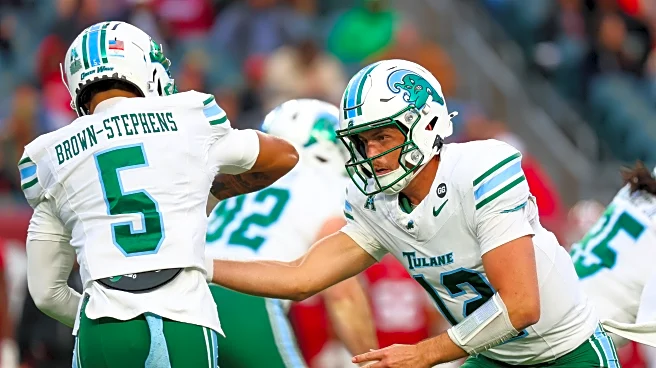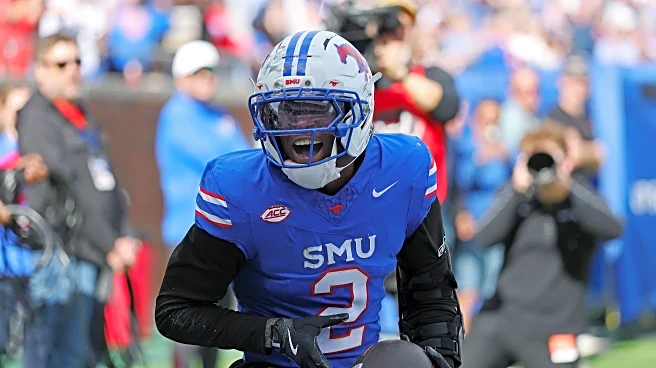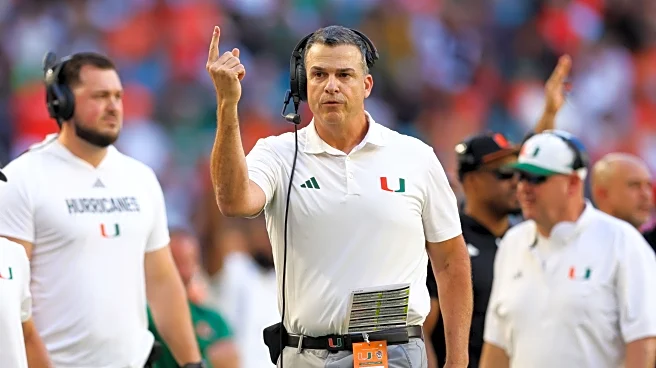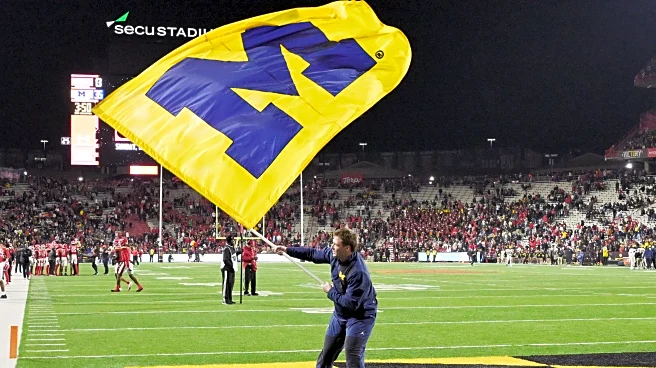A couple of Mountain West players were listed as semifinalists for these awards. Some of these will be narrowed down to finalists over the next two weeks, and I’ll do my best to give updates on those who
made the cut, but I wanted to highlight these players. It shows how the Mountain West is still getting solid players, despite NIL and the transfer portal being such a big factor.
I’ll put in a quick side note before I get started. For most of these awards, they don’t make a public announcement of who are the semi-finalists or finalists. Typically they contact the university the player/coach is at, who will then make an announcement. This makes it hard when you’re trying to see who made the cut, especially when there are some 20 awards. Others aren’t announced until later in the season. Like I put this together over the past week, but then literally yesterday Boise defensive Coordinator Erik Chinander was listed as a nominee for the Broyles Award, given to the nation’s best assistant coach (you can participate in the fan vote here, though the voting hasn’t gone live at the time of publishing this). Then the same day, Hawaii’s head coach Timmy Chang was named the coach of the year for his region.
If there’s a player or coach that was a semi-finalist (or even finalist) that I didn’t cover, please mention them in the comments. I promise I’m not picking and choosing who to highlight!
We’ll start off with one that, quite frankly, I never would have guessed back in August:
Shaun Alexander Award – Nation’s Best Freshman
Micah Alejado, Quarterback,Hawaii
The Shaun Alexander award started in 2019 and is given to the top Freshman, named after former All-Pro and Alabama alumnus Shaun Alexander. It’s a “position-less” award, but naturally most of the semifinalists are quarterbacks.
Alejado had some playing time as a true freshman (but not so much he couldn’t redshirt). His first start had him throwing 469 yards and five touchdowns.
His first three games this year weren’t great. – three touchdowns to four interceptions – but since then he’s been on a tear. In that stretch he’s second nationally in passing yards per game and had five straight games with three touchdown. PFF also has him 17th in “Big Time Throw Percentage”, which are passes that are aggressively, but accurately, thrown down field (min 300 attempts). Basically he’s a gunslinger and good at it.
The random fact I love about him is that he’s a left-handed quarterback. I couldn’t find a number of left handed quarterbacks currently playing in the FBS, but I know there aren’t many.
The Competition
The Shaun Alexander award is newer, only starting in 2018, but one winner has been from the Group of 5 – Kenneth Gainwell from Memphis in 2019. This year there have been some great freshman quarterbacks. Bear Bachmeier at BYU has been a great dual threat, Drew Mestemaker at North Texas has been one of the more productive quarterbacks nationwide. My guess is Notre Dame’s CJ Carr will win. Of the freshman quarterbacks nominated, Carr has been on the best team while still playing efficient.
Finalists are announced December 3rd and the winner December 30th.
Burlseworth Award – Nation’s Best Walk-On
Bryson Barnes, Quarterback, Utah State
Barnes came from the thriving metropolis of Milford Utah (population of 1,400) where he grew up a pig farmer. Just a good ol’ country boy if there was one.
He walked on to University of Utah in 2021 and the college football world first saw him in the Rose Bowl that year against Ohio State. Starting quarterback Cam Rising went out with injury (which happened a lot), then Barnes came in and threw a touchdown to tie the game:
In 2023 Barnes filled in for the still injured Rising, winning his first four starts against Florida, Baylor, California, and USC. Pretty dang good! But things went downhill after that, going 1-5 the rest of the year. After the year ended, Barnes decided to transfer 1 1/2 hours north to Utah State.
In 2024 Utah State also brought in Spencer Petras through the portal and both got playing time. Petras didn’t turn the ball over as much as Barnes, but on a play-by-play basis, Barnes looked better, and ended the season strong. Those final two games in 2024, Barnes had a combined total of 706 yards (including 378 rushing yards) and eight total touchdowns.
Barnes carried that over to 2025, where he’s kept up his elite dual-threat play. Among quarterbacks this year, Statmuse has him second in rushing yards and third in rushing touchdowns. In the Mountain West, Barnes is fourth in yards per game, second in passing touchdowns, while also second in passer rating and yards per attempt.
The Competition
Last year’s winner, Oregon linebacker Bryce Boettcher, is again a semifinalist, and could join Baker Mayfield as the only two-time winners. Boettcher’s stats aren’t as good as last year, but he’s still a great defender on a good Oregon team, and can score on offense:
Another notable walk on is North Texas quarterback Mestemaker, who is also a semi finalist for the Shaun Alexander Award. Finalists will be announced December 3rd, and the winner December 30th.
Doak Walker Award – Nation’s best Running Back
Lucky Sutton – San Diego State
San Diego State has had some great running backs. The FBS leader in rushing yards, Donnell Pumphrey, and NFL Hall of Famer Marshall Faulk both went to San Diego State. Last year’s winner, Ashton Jeanty of Boise State, was the first winner to not come from a major conference since Luke Staley won it at BYU in 2001 (who, coincidentally, was also in the Mountain West that year).
Sutton’s story is great because he only had 37 carries in his first three seasons, then broke out in 2025. Really it’s a big factor in why San Diego had such a turnaround from last year. San Diego went 3-9 in 2024, their worst season in 16 years, to first in the conference. Their rushing game went from 99th in yards per game (128) to 34th (187). Part of that is they do a have a great line, 39th highest run-block grade per PFF, but Sutton’s 732 yards after contact are 11th most in the FBS. He’s currently ninth in rushing yards on the season at 1,127.
The Competition
Sutton unfortunately wasn’t named a finalist, but being a semi-finalist is still a huge accomplishment, especially when there are some 300 – 500 running backs in all of college football. My guess for the winner is Jeremiah Love from Notre Dame, who has pretty much been in the discussion all year. If you haven’t watched Love run, please enjoy this masterpiece:
Put in in the Louvre.
Lou Groza Award – Nations Best Kicker
The Mountain West actually had two semifinalists for this award
Kansei Matsuzawa – Hawaii
Japan is sending some solid athletes to the US recently. They gave the Dodgers Yoshinobu Yamamoto and Shohei Ohtani. Then they gave Hawaii the Tokyo Toe (fantastic nickname, by the way). If you haven’t heard his story yet, it’s a great one you can read up on. The article goes into more detail, but basically he taught himself English and kicking through YouTube. He was one of the few people who watched something challenging, thought to himself, “I could do that”, and actually did. His first year at Hawaii was solid, going 12-16 on the year and perfect on all 32 extra points. In 2025 he started strong, making a game winning field goal against Stanford in week 1:
People have taken notice, as he was on the AP’s Mid-Season All America Team. This year he’s the only kicker who is perfect on all extra points and field goals, including 9-9 from beyond 40 yards (just don’t mention this during a game. Don’t be the one to jinx it). His 23 made field goals also lead the nation.
Gabriel Plascencia – San Diego State
While Plascencia isn’t perfect on kicks, he’s pretty close. Right now he’s 18-20 on the year, including 10-11 for kicks from 40 yards out. He essentially won the game for San Diego when then played Northern Illinois in a 6-3 win back in September, where all of San Diego’s points were field goals.
For his career he’s 35-38, the conference reported this after he was announced as a semifinalist:
Plascencia made 26 consecutive field goals before missing his second attempt against Wyoming on Nov. 1, which was longest streak in program history, the longest in Mountain West history and the longest active streak in the country. Plascencia went 427 days without missing a field goal from Aug. 31, 2024 to Nov. 1, 2025.
Kickers don’t always get much attention when they play well, but they do get a lot when they are bad. Luckily for Plascencia he’s flown under the radar in this sense.
The Competition
Depending on how things go these next few weeks, there is a chance Matsuzawa could win it. Matsuzawa was named a finalist yesterday (Plascencia was not, unfortunately), and five winners have come from non-Power conference schools. I think the other candidate to keep an eye on is Oklahoma’s Tate Sandell. He’s 7-7 on field goals from 50 yards out. The second best from that distance is 4-6. The kicker revolution continues.
The winner will be announced December 8th.
Patrick Mannaly Award – Best Long Snapper
Mason Hutton – Boise State (link is for bio on Boise State’s website)
I’ll be honest, I had no idea there was an award for best long snapper. But hey, an award is an award!
There really aren’t any stats for long snappers – but we know how many points Lebron averages on Wednesdays. But from his bio, he’s been the long snapper for four years at Boise State, and sounds like he hasn’t missed one. Not many people can say they’ve done something perfect for four years.
The good news for him is he’s 6-5, 230 lbs, and a good athlete, which is exactly what the NFL looks for in long snappers. It’s a position that doesn’t help much when you’re good at it, but can cause horrible problems if you’re bad. Hutton may end up having a pro career.
The finalists will be announced December 1st and the winner announced December 13th.
Fred Biletnikoff Award – Top Wide Receiver
Danny Scudero – San Jose State
San Jose Last year had Nick Nash finish as a finalist for the Biletnikoff award, finishing the regular season as the leader in receptions, yards, and touchdowns – the receiving triple crown (though he was surpassed in receptions and yards once post-season play started, which he didn’t participate in). San Jose lost him and fellow standout Justin Lockhart, who had 983 yards to go with Nash. There were some questions about who will fill the void.
Enter the 5-9 170 lb Scudero, a transfer from Sacramento State. Phil Steele had him second team all FCS in 2024, and had him on the second all conference team back in the preseason. Steele was onto something, as the AP had him second team on their mid-season list this year.
Scudero is currently sixth in touchdowns, fourth in receptions, and second in yards. He’s most dangerous in the slot, where he’s has an FBS best 1,024 yards.
The Competition
Scudero didn’t the make cut for the finalists, but honestly Jeremiah Smith at Ohio State may have locked it up with this catch:
Or this one:
With Smith making plays like that, it’s hard to stand out as a receiver. Like how every good running back last year was overshadowed by Jeanty. A cool thing about this is there is a fan vote (click here if you like), which had Scudero listed before the finalists were announced. I’m proud to say I was one of the 0.67% to voted for Scudero!
The winner will be announced December 12th.
George Munger Coach of the Year
Sean Lewis – San Diego State
San Diego state went 7-17 from 2023-2024, their worst two year stretch since the 2008-2009 years. They had a lot of success with Rocky Long, winning the conference in 2015 and 2016. Even though Brady Hoke’s tenure didn’t end well, he still had the team end the 2021 year ranked at 24. Sean Lewis arrived in 2024, and didn’t start well with a 3-9 record. The Mountain West Media voted them eighth in the preseason, and us at Mountain West Connection were even more pessimistic, voting them 10th; the best any of us voted them was seventh. But I’m ok with being this kind of wrong.
The two hardest things to do in coaching are arguably quick turnarounds and sustained success across a period of time. The latter is mainly highlighted by the Hall of Fame, so quick turnarounds are pretty much the benchmark for coach of the year. We can compare win totals by year to year to judge those, but those don’t tell the full story. If you lost a number of one score games one year, not as much as the next, how much of that is luck versus correcting a small mistake?
So to double down on my data-nerd personality, I looked at three things for all teams across the 2024 and 2025 season:
- Total Change in Wins
- Total Change in SRS
- Total Change in Pythagorean Expectation
SRS, or Simple Rating System, is the difference between your teams average margin of victory and your opponents average margin of victory (i.e. your team wins by 10 against a team that normally loses by 7, so your score is 3 for that game). A close loss to a great team is better than a big win over a middling team. The Pythagorean Expectation started in baseball, but I used a modified version for football. Basically it’s a way to predict how many games a team should have won based on points they scored and allowed. It accounts for games won or lost by luck, since a team losing eight games by a few points is probably better than a team who lost eight games by a lot.
San Diego’s change in win total – from three to nine – is tied for first with Southern Mississippi and Kennesaw State. But for those other two metrics I looked at, San Diego finished second and third, with Kennesaw State as the only other school to finish top five in all three categories.
The two biggest reasons for that change were improving the run game, which I somewhat highlighted with Lucky Sutton earlier, and their massive turnaround in their defense. They went from allowing 29.6 points a game in 2024 (ranked 99th) to 11.6 this year (tied for 2nd best). But how? They’ve averaging about the same number of sacks, tackles for loss, and turnovers per game. I did see their third down defense improved quite a bit, allowing 46% in 2024 to 32% this year. But how does that happen?
My best guess is they worked on the basics. I looked at PFF, and found they dramatically improved at tackling. Last year they were credited with missing 156 tackles, or 13 a game, and were ranked 121st in tackling grade. This year that average has dropped to 8 a game, and overall shot up to ranked 23rd in tackling. Per college football data, their rate of passing downs they play (2nd and 7 or longer, 3rd and 5 or longer) has increased from 28% to 37%. Making simple tackles on early downs forced opposing teams to pass more, which no team, no matter how good, wants to be coerced into.
On offense their passing game hasn’t improved. In fact, it might be worse: they’ve been averaging 50 fewer passing yards per game and their passer rating is about the same. Their touchdown and interception rate have also gotten worse. But their running game is really where they’ve improved. On top of gaining about 60 more yards a game, they’re more efficient at it. Again from collegefootballdata.com, their percentage of runs considered successful went from from 37% to 45% (50% of necessary yards on 1st down, 70% on second, 100% on 3rd/4th).
What I find interesting about this, is Lewis is known for his passing offense, and most of us predicted he would focus on that. Instead he focused on improving everything else. To me that is the mark of a good coach. Focusing on the strengths you have instead of trying to do what you’ve always done.
The Competition
The only other semifinalists that also had huge improvements from last year were Jerry Mack at Kennesaw State and Tony Ellion at Virginia. The rest are pretty much coaches for highly ranked teams:
My guess is it’ll be Mike Elko at Texas A&M. If they win the SEC, I think he walks away with the award. Otherwise, I’ll say it’s whoever comes out on top between Curt Cignetti at Indiana and Ryan Day at Ohio State, assuming one of them wins the BIG 10. But if they all implode and San Diego sneaks into the playoff, Lewis could be a legitimate dark horse.
The finalists will be announced December 8th and the winner December 30th.
Conclusion
We always talk about whether the smaller schools will keep up, but honestly after reviewing the semi finalists for national awards two years in a row now, I’m surprised by the talent that comes in. Of the eight guys I highlighted here, few had high expectations when they got on campus. Most were walk-ons, a few started in JUCO or FCS schools, and one patiently rode the bench for three years. Even last year some players didn’t have a “normal” story. Nick Nash started as a quarterback before becoming one of the most productive receivers in the nation. Asthon Jeanty was a wide receiver when he first committed to Boise state, then became a Heisman Runner up as a running back.
It’s easy to assume the big schools monopolize the talent, but they don’t monopolize the attention. I don’t know how many of these individuals will win these awards or even be included as a finalist, but it’s clear the Mountain West is still bringing in solid talent.












